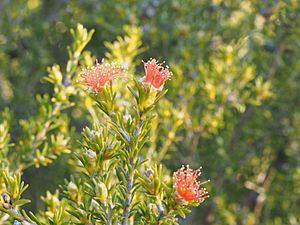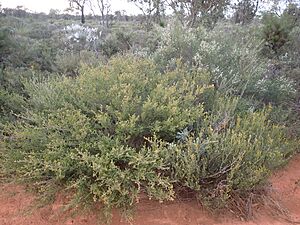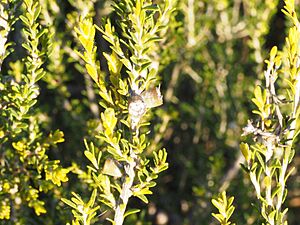Eremaea pauciflora facts for kids
Quick facts for kids Eremaea pauciflora |
|
|---|---|
 |
|
| E. pauciflora leaves and flowers | |
| Scientific classification | |
| Genus: |
Eremaea (plant)
|
| Species: |
pauciflora
|
| Synonyms | |
|
Melaleuca rariflora Craven & R.D.Edwards |
|
Eremaea pauciflora is a special plant that belongs to the myrtle family, called Myrtaceae. It grows only in the south-west part of Western Australia, which means it's endemic there. This plant is a shrub with small leaves and pretty orange flowers that grow at the ends of its branches. It's one of the most common types of Eremaea plants and comes in many different forms. In fact, scientists recognize three main types of this plant. It was the first Eremaea plant to be officially described, but it wasn't originally given the name Eremaea.
Contents
What Does Eremaea pauciflora Look Like?
Eremaea pauciflora is a shrub that can grow upright, spread out, or be very bushy and rounded. It sometimes reaches a height of about 2 metres (7 ft). Its leaves are small, usually 2.9–7.9 millimetres (0.1–0.3 in) long and 0.6–3.3 millimetres (0.02–0.1 in) wide. They are shaped like a narrow egg or a line, with the narrower end at the bottom. Sometimes, you can see one or three veins on the underside of the leaves.
The flowers of this plant are bright orange. They grow one or two at a time on the ends of long branches that grew the year before. Each flower has five sepals, which are very hairy on the outside. There are also five petals, each about 2.5–5.7 millimetres (0.1–0.2 in) long. Inside the flower, the stamens (the parts that make pollen) are grouped into five bundles. Each bundle can have 17 to 47 stamens!
Eremaea pauciflora flowers from July to January. After the flowers, the plant produces woody capsules, which are like small seed pods. These capsules are 6–9.2 millimetres (0.2–0.4 in) long, smooth, and can vary in shape.

How Eremaea pauciflora Got Its Name
Eremaea pauciflora was first described in 1837 by an Austrian botanist named Stephan Endlicher. He originally called it Metrosideros pauciflora. Later, in 1839, another botanist named John Lindley described the first plant to be named Eremaea, which was Eremaea fimbriata. He thought that Endlicher's Metrosideros pauciflora might actually be an Eremaea plant. Finally, in 1917, George Claridge Druce officially gave it the name Eremaea pauciflora.
The second part of its name, pauciflora, comes from two Latin words. "Pauci" means "few" and "flora" means "flower". So, pauciflora means "few-flowered".
In 1998, a scientist named Roger Hnatiuk looked closely at Eremaea pauciflora and found three different types, or varieties:
- Eremaea pauciflora var. pauciflora: This type has linear (line-shaped) leaves with just one vein. Its fruits have a very narrow opening. You can find it across most of the south-west of Western Australia, and even in drier areas like the Coolgardie region.
- Eremaea pauciflora var. lonchophylla: This type has narrow, oval-shaped leaves with one or three veins. It grows in areas close to the coast between Perth and Geraldton.
- Eremaea pauciflora var. calyptra: This type also has linear leaves, but its fruits are cup-shaped with a wide opening. It also grows in coastal areas between Perth and Geraldton.
Where Does Eremaea pauciflora Grow?
Eremaea pauciflora is found all over the south-west region of Western Australia. It even grows in some of the drier, more desert-like areas. You can find it in many different places, like sandy soil, sandy clay on flat plains, on hillsides, and in low areas that get wet during winter.
Is Eremaea pauciflora Protected?
The Western Australian Government's Department of Parks and Wildlife has classified Eremaea pauciflora as "not threatened." This means it is not currently in danger of disappearing.


